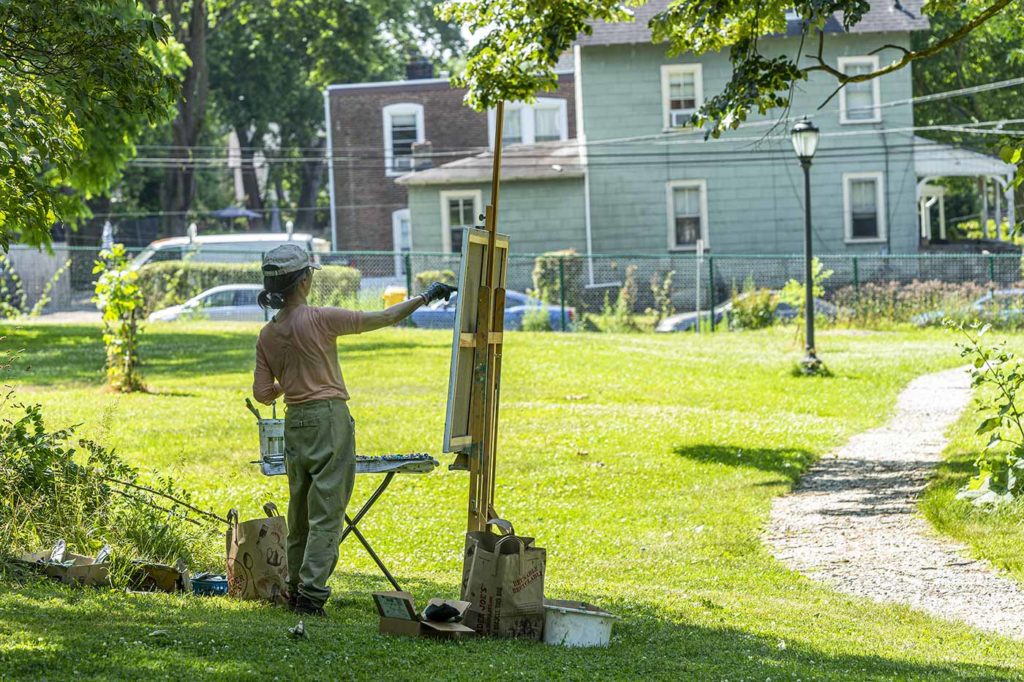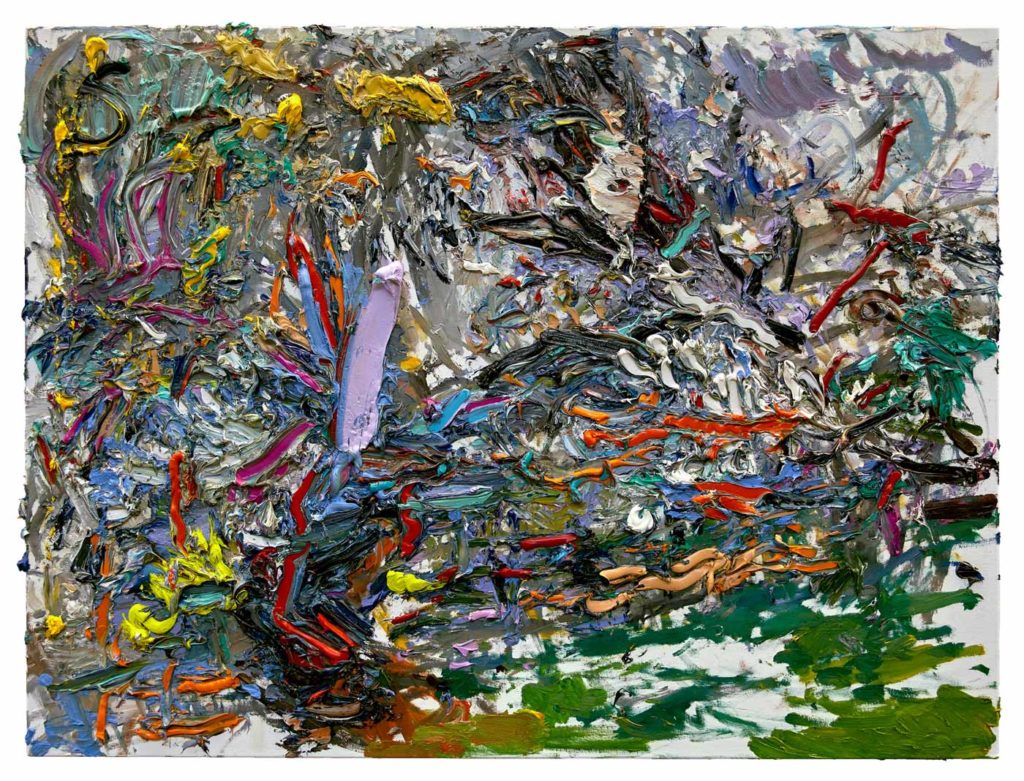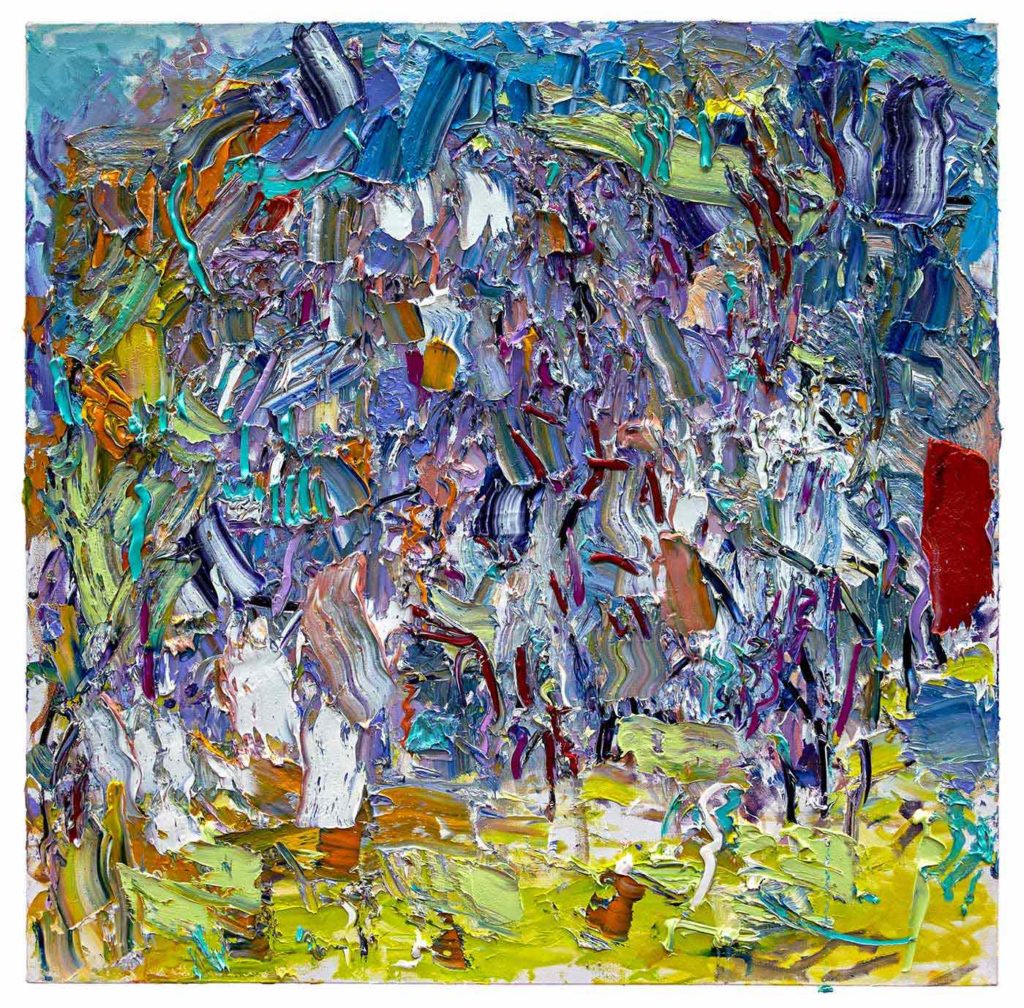In early March, 2020, Haverford College, like educational institutions throughout the country, closed its campus to visitors and moved classes online in order to mitigate the effects of the Covid-19 pandemic. In the months that followed, Ying Li, a professor of fine arts at Haverford, responded to the crisis with astonishing and prolific creativity. Comprising 47 paintings created in just five months, Blossoms in a Sudden Strangeness reflects a profound aesthetic discipline honed over more than 50 years. Li began each painting through closely observing subjects she discovered in or near her apartment on Haverford’s campus, such as the view from her porch or cherry trees in bloom. Responding to beauty and ephemerality in nature, she abstracts and reworks each composition until her expressive gestures and densely layered surfaces convey the complexity of her observations over time. Reveling in possibility, not perfectionism, she adds, spreads, and scrapes away paint, creating relief-like topographies. Amid the “sudden strangeness” of the pandemic, Li was fortunate to safely remain on campus, taking inspiration from flora and fauna that have fascinated her for more than 25 years.

Li’s creative resilience is rooted in her past experiences with cultural upheaval and personal hardship. To understand her tireless work ethic and vibrant curiosity, it is helpful to consider her upbringing, training, and artistic evolution. Born in 1951 in Beijing, China, Li came of age during the so-called “Great Proletarian Cultural Revolution” (1965–77). In 1967, her father, a scholar of Russian literature, was arrested and accused of counter-revolutionary activity. At the age of sixteen, Ying was separated from her parents and sister and forced to labor and be “re-educated” for five and a half years on rural farmland in Anhui Province. Like many others, she suffered from food scarcity. Occasionally, she was required to create propaganda posters and murals and to paint in the socialist realist style. Undeterred, she used some of the supplies issued by the state for propaganda to practice painting in Western styles and to explore her own aesthetic. As the noted art critic, Faye Hirsch, has written, “It is no exaggeration . . . nor overly dramatic, to say that painting has been, for Li, a matter of survival. In China, painting was something that could be entirely hers in a milieu that demanded the relinquishing of the most personal matters to what was deemed to be the social good.”[1]
In 1974, Li suffered a knee injury and was sent back to the city of Hefei, where she applied to Anhui Teachers University to study art. Although gender bias and lingering stigma related to her father’s arrest prevented her from gaining admission, she persisted. Standing at the entrance to the university, she painted there each day until a sympathetic teacher risked his own career to advocate on her behalf. When finally admitted, she explored varied approaches to painting, from traditional Chinese calligraphy to impressionist techniques. After completing her degree in 1977, she joined the faculty and taught there for six years.
Li enrolled at Parsons School of Design in 1984, earning her M.F.A. in 1987. At Parsons, Li studied with Leland Bell, a passionate teacher and contrarian, who advocated painting from observation and introduced his students to French modernists, such as Alberto Giacometti, Jean Hélion, and André Derain, who were little known at the time. While many American artists in the 1980s were embracing postmodernism, identity politics, and styles that emphasized appropriation and irony, Bell extolled ambitious landscapes and figure groups by Gustave Courbet, the paragon of 19th-century Realism, and intimate paintings by Jean-Baptiste-Siméon Chardin, the 18th-century master of still life and genre scenes. Bell encouraged students to study such art empirically in museums and revise their own works unstintingly. Li also sought mentoring from strong women, and she became especially close with Lois Dodd and Pat Passlof, both accomplished painters who were also widely admired as teachers.
Several important discoveries helped Li work within traditional genres without painting generically. In December 1983, just a few months after moving to New York, she was profoundly inspired by Willem de Kooning’s 60-year retrospective exhibition at the Whitney Museum of Art. She also developed a strong affinity for the art of Alberto Giacometti and Chaim Soutine. Whereas many influential artists and critics viewed Abstract Expressionism and related styles as passé, and the New York art world often prized novelty above all else, Li did not view Expressionism as a finite style, but a set of guiding principles.
Discovering her passion for live jazz performance also liberated Li, not only from the dictates of social realism, but from an imitative approach to Western modernism. In fall 1983, the day after she emigrated from China, she heard Abdullah Ibrahim, a South African jazz pianist, perform at Sweet Basil, one of the most prominent clubs in Greenwich Village. Feeling an immediate connection, Li and her husband began to regularly visit jazz venues such as Village Vanguard, Blue Note, Smoke, and Jazz Standard. She often listened to musicians such as Dexter Gordon, Horace Silver, Hank Jones, and Keith Jarrett. Li could be describing her own goals when she expresses special admiration for John Coltrane, saying, “he was so innovative, always searching. He had no fear, no hesitation. He put himself entirely in his music, making himself vulnerable.” [2]
While speaking English was still a challenge, jazz provided a common language with other artists, and it was often a topic of discussion with Leland Bell, who was a jazz drummer before he became a painter. After her husband’s death in 2012, Li visited clubs by herself to draw and absorb the intense energy, call-and-response dynamism, and specificity of live performances. Although jazz venues closed in early 2020 to mitigate the transmission of Covid-19, Li lives with her partner, the noted jazz trombonist Conrad Herwig, and often listens to him play. Both artists have spent decades cultivating disciplined routines that allow them to remain authentic, engaged, and creatively responsive, even when under duress.

Cherry Trees of the Duck Pond, 2020, oil on linen, 30 x 40 inches 
Cherry Blossom, 2020, oil on canvas, 48 x 48 inches
Although Li immediately fell in love with jazz and Abstract Expressionism in the 1980s, integrating their principles into her own practice took many years. Back in the early 1990s, Li had mainly been painting semi-abstract still lifes, portraits, and interiors, initially exhibiting them at venues such as the Bowery Gallery, an artist cooperative, which was at the time located in Soho. Then, in 1994, she was awarded an artist residency at Chateau Rochefort-en-Terre, Brittany, France, and the experience was transformative. Setting up her portable easel before dramatic vistas, she knew she did not want her paintings to merely document or illustrate the landscape, but she was not sure how to represent the complexity of her specific observations, changing atmospheric conditions, or her own varied responses over time. Li struggled at first, but also felt excited as she began to integrate gestural and experimental strategies used by abstract expressionists with her earlier training in Chinese calligraphy.
For masters of Chinese calligraphy, decades of preparation come to fruition in a succinct and fluid action. Synthesizing both spontaneity and disciplined practice, a single brushstroke can be simultaneously descriptive, emotionally expressive, conceptually complex, and spatially dynamic. While continuing her lifelong practice and study of calligraphy, Li has also found a touchstone in the six principles of Chinese painting articulated by Xie He (Hsieh Ho) in the 5th century. These principles include a concern for the communicative essence of one’s materials, the importance of copying models from both nature and the masters, and, most importantly, the expression of “spirit resonance,” or vitality.
As an emerging artist in the 1990s, Li cultivated spirit resonance, not as an innate gift or visual effect, but as a quality that one continually strives for through tireless study, practice, and experimentation. She sought out new challenges by teaching for eight summers at the International School of Art in Montecastello di Vibio, Italy and completing more than 25 artist residencies throughout the world, including at the Aspen Institute in Colorado, Centro Incontri Umani Ascona in Switzerland, and the Valparaiso Foundation in Spain. Such experiences have reinforced her ability to adapt to change, identify qualities unique to each setting, and paint for long periods while working in relative isolation.
Although Li regularly seeks inspiration in exotic or picturesque locales, she is also fascinated by quotidian objects and domestic scenes. In February 2020, just before the pandemic became acute, Li was on academic leave in New York, completing a series of urban landscapes. In March, when it became clear that people would need to avoid travel and close physical contact, Li and Herwig moved to Haverford’s campus, where she promptly started painting views from her wooden porch. One day, she found an empty nest and placed it on the porch railing to study its structure and associative resonance. The resulting painting An Empty Nest, provides an apt metaphor for the sudden dearth of students and visitors on a normally bustling campus—and for broader experiences of dislocation and transition.
Blossoms in a Sudden Strangeness includes a selection of 20 paintings on paper that emphasize a more direct and intimate approach than her larger paintings on canvas. Sketching her subjects with loose, wiry lines and deploying a subdued palette, often with thin veils of translucent paint, Li conveys a sense of humility and vulnerability. Affixing her signature stamp and the date in the lower right hand corner of each work, she encourages us to consider these paintings as a diaristic response to the Covid-19 pandemic. Three paintings wryly portray Kleenex boxes, prosaic objects that suddenly attained new importance as many people began to hoard health-care and cleaning products. Most of the works on paper allow Li to revisit places that she has often painted in the past, such as Haverford’s duck pond and organic farm. Other images reflect the way wildlife seemed more abundant as the local population and car traffic diminished. In her playfully titled painting, Haverfox, Li places a fox in the center of the composition, and it seems to stare directly at the viewer, as if frozen in surprise.
Another image shows a fox trotting away—a reminder of how our perceptions of nature are often fleeting and incomplete.
Blossoms in a Sudden Strangeness also features 27 paintings on canvas that are ambitious in scale and scope. Li animates such compositions with an adventurous palette—a broad spectrum of hues, including acidic greens and intense reds, sweet pastels, “out of the tube” color, and multi-colored mixtures that alternately reveal or conceal underlying layers.
One of many intriguing works, March of the Daffodils, captivates our attention with bold vertical gestures: two-inch-wide swaths that mix, smear, and flatten an underlying terrain created with myriad, varied, and colorful strokes. Suggesting calligraphic marks or letters in an unknown language, these bold elements bracket the right side of the composition, where concentrations of yellow— presumably the daffodils—provide a brief moment of focus amid surrounding dynamism and complexity. When viewed from a distance, such paintings appear airy and effortless—as vibrant and refreshing as daffodils in springtime. As we draw closer, we become more aware of diverse underlying concerns. In varying ways, each canvas demonstrates the elasticity of painting media, the mutability of perception, and above all, the artist’s vibrant and unifying spirit.
Amid the Covid-19 pandemic and interrelated environmental and political crises, Yi continues to paint with both existential urgency and verve. Celebrating the restorative power of beauty, she models qualities we need now, more than ever, not the least of which are empathy, intellectual curiosity, and resilience.
Footnote
- Faye Hirsch, “The Interiorized Landscapes of Ying Li” in Ying Li, an exhibition published by the List Gallery, Swarthmore College, 2010.
- Email exchange with the artist, September 3, 2020.

Bio:
Andrea Packard is a mixed media artist and curator who focuses on the way art can develop environmental awareness, challenge cultural biases, and foster community. She has directed the List Gallery, Swarthmore College since 1995, and curated more than 150 exhibitions for Swarthmore and varied galleries throughout the United States. Her work is held in diverse collections, such as the Woodmere Art Museum, Philadelphia, and she has been awarded fellowships or residencies by varied institutions including The Center for Emerging Visual Artists, Pennsylvania Academy of the Fine Arts, American University, Hudson River Museum, Albert and Anni Albers Foundation, Vermont Studio Center, and Saint Mary’s College, Maryland. Her work can be viewed at AndreaPackard.net.

